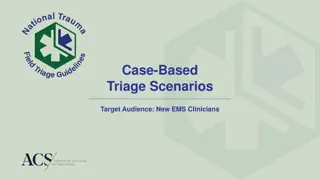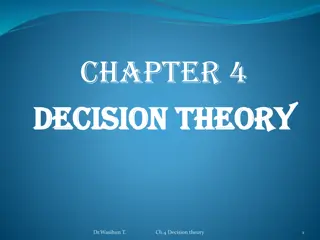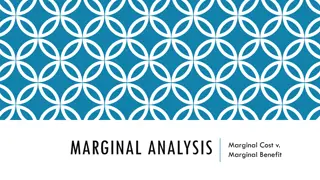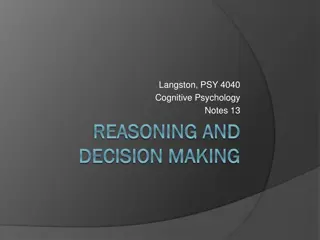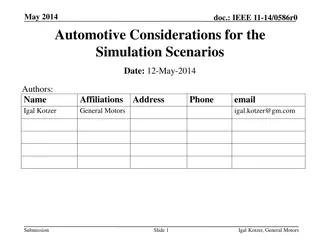Understanding Decision Analysis in Work-related Scenarios
Decision analysis plays a crucial role in work-related decision-making processes, helping in identifying decision makers, exploring potential actions, evaluating outcomes, and considering various values involved in the decision. This module delves into the steps involved in decision analysis, providing a structured approach to tackle complex decisions. Through the analyst's assistance, decision makers can navigate uncertainties, clarify values, and ultimately recommend the best course of action.
Download Presentation

Please find below an Image/Link to download the presentation.
The content on the website is provided AS IS for your information and personal use only. It may not be sold, licensed, or shared on other websites without obtaining consent from the author. Download presentation by click this link. If you encounter any issues during the download, it is possible that the publisher has removed the file from their server.
E N D
Presentation Transcript
The process of Decision Analysis Baba Maiyaki Musa MBBS MPH FWACP
At the end of this module the student will be able to : describe a nonclinical work-related decision. Describe who makes the decision, what actions are possible, what the resulting outcomes are, and how these outcomes are evaluated: He would also appreciate : 1. Who makes the decision? 2. What actions are possible (list at least two actions)? 3. What are the possible outcomes? 4. Besides cost, what other values enter these decision? 5. Whose values are considered relevant to the decision? 6. Why are the outcomes uncertain?
Any time a selection must be made among alternatives, a decision is being made, and it is the role of the analyst to assist in the decision-making process. When decisions are complicated and require careful consideration and systematic review of the available options, the analyst s role becomes paramount. An analyst needs to ask questions to understand : who the decision makers are, what they value, and what complicates the decision. The analyst deconstructs complex decisions into component parts and then reconstitutes the final decision from those parts using a mathematical model. In the process, the analyst helps the decision maker think through the decision
Some decisions are harder to make than others. For instance, some problems are poorly articulated. In other cases, the causes and effects of potential actions are uncertain. There may be confusion about what events could affect the decision. Decision analysis provides: structure to the problems a manager faces, reduces uncertainty about potential future events, helps decision makers clarify their values and preferences, and reduces conflict among decision makers who may have different opinions about the utility of various options.
We would outline the steps involved in decision analysis, Including exploring problems clarifying goals, identifying decision makers, structuring problems, quantifying values and uncertainties, analyzing courses of action, and finally recommending the best course of action. This module provides a foundation for understanding the purpose and process of decision analysis.
Who Is a Decision Maker? The decision maker receives the findings of the analysis and uses them to make the final decision. One of the first tasks of an analyst is to clarify who the decision makers are and what their timetable is.
Throughout the book, the assumption is that at least one decision maker is always available to the analyst. This is an oversimplification of the reality of organizations. Sometimes it is not clear who the decision maker is. Other times, an analysis starts with one decision maker who then leaves her position midway through the analysis; one person commissions the analysis and another person receives the findings. Sometimes an analyst is asked to conduct an analysis from a societal perspective, where it is difficult to clearly identify the decision makers. All of these variations make the process of analysis more difficult.
What Is a Decision? This module is about using analytical models to find solutions to complex decisions. . Most individuals go through their daily work without making any decisions. They react to events without taking the time to think about them. When the phone rings, they automatically answer it if they are available. In these situations, they are not deciding but just working. Sometimes, however, they need to make decisions. If they have to hire someone and there are many applicants, they need to make a decision. One situation is making a decision as opposed to following a routine.
To make a decision is to arrive at a final solution after consideration, ending dispute about what to do. A decision is made when a course of action is selected among alternatives. A decision has the following five components: 1. Multiple alternatives or options are available. 2. Each alternative leads to a series of consequences. 3. The decision maker is uncertain about what might happen. 4. The decision maker has different preferences about outcomes associated with various consequences. 5. A decision involves choosing among uncertain outcomes with different values.
What Is Decision Analysis? Analysis is defined as the separation of a whole into its component parts. Decision analysis is the process of separating a complex decision into its component parts and using a mathematical formula to reconstitute the whole decision from its parts. It is a method of helping decision makers choose the best alternative by thinking through the decision maker s preferences and values and by restructuring complex problems into simple ones. An analyst typically makes a mathematical model of the decision.
What Is a Model? A model is an abstraction of the events an relationships influencing a decision. It usually involves a mathematical formula relating the various concepts together. The relationships in the model are usually quantified using numbers. A model tracks the relationship among various parts of a decision and helps the decision maker see the whole picture.
What Are Values? A decision maker s values are his priorities. A decision involves multiple outcomes and, based on the decision maker s perspective, the relative worth of these outcomes would be different. Values show the relative desirability of the various courses of action in the eyes of the decision maker. Values have two sides: cost and benefits.
Cost is typically measured in dollars and may appear straightforward. However, true costs are complex measures that are difficult to quantify because certain costs, such as loss of goodwill, are nonmonetary and not easily tracked in budgets. Furthermore, monetary costs may be difficult to allocate to specific operations as overhead, and other shared costs may have to be divided in methods that seem arbitrary and imprecise.
Benefits need to be measured on the basis of various constituencies preferences. Assuming that benefits and the values associated with them are unquantifiable can be a major pitfall. Benefits should not be subservient to cost, because values associated with benefits often drive the actual decision. By assuming that values cannot be quantified, the analysis may ignore concerns most likely to influence the decision maker.
An Example A hypothetical situation faced by the head of the state agency responsible for evaluating nursing home quality can demonstrate the use of decision analysis. A nursing home has been overmedicating its residents in an effort to restrain them, and the administrator of the state agency must take action to improve care at the home. The possible actions include fining the home, prohibiting admissions, and teaching the home personnel how to appropriately use psychotropic drugs.
Any real-world decision has many different effects. For instance, the state could institute a training program to help the home improve its use of psychotropic drugs, but the state s action could have effects beyond changing this home s drug utilization practices. The nursing home could become more careful about other aspects of its care, such as how it plans care for its patients. Or the nursing home industry as a whole could become convinced that the state is enforcing stricter regulations on the administration of psychotropic drugs. Both of these effects are important dimensions that should be considered during the analysis and in any assessment performed afterward.
The problem becomes more complex because the agency administrators must consider which constituencies values should be taken into account and what their values are regarding the proposed actions. For example, the administrator may want the state to portray a tougher image to the nursing home industry, but one constituent, the chairman of an important legislative committee, may object to this image. Therefore, the choice of action will depend on which constituencies values are considered and how much importance each constituency is assigned.
Prototypes for Decision Analysis Real decisions are complex. Analysis does not model a decision in all its complexity. Some aspects of the decision are ignored and not considered fundamental to the choice at hand. The goal is not to impress, and in the process overwhelm, the decision maker with the analyst s ability to capture all possibilities. Rather, the goal of analysis is to simplify the decision enoughto meet the decision maker s needs. An important challenge, then, is to determine how to simplify an analysis without diminishing its usefulness and accuracy. When an analyst faces a decision with interrelated events, a tool called a decision tree might be useful.
Over the years, as analysts have applied various tools to simplify and model decisions, some prototypes have emerged. If an analyst can recognize that a decision is like one of the prototypes in her arsenal of solutions, then she can quickly address the problem. Each prototype leads to some simplification of the problem and a specific analytical solution. The existence of these prototypes helps in addressing the problem with known tools and methods.
Following are five of these prototypes: 1. The unstructured problem 2. Uncertainty about future events 3. Unclear values 4. Potential conflict 5. The need to do it all
Prototype 1: The Unstructured Problem Sometimes decision makers do not truly understand the problem they are addressing. This lack of understanding can manifest itself in disagreements about the proper course of action. The members of a decision-making team may prefer different reasonable actions based on their limited perspectives of the issue. In this prototype, the problem needs to be structured so the decision makers understand all of the various considerations involved in the decision. An analyst can promote better understanding of the decision by helping policy makers to explicitly identify the following:
Individual assumptions about the problem and its causes Objectives being pursued by each decision maker Different perceptions and values of the constituencies Available options Events that influence the desirability of various outcomes Principal uncertainties about future outcomes
A good way to structure the problem is for the analyst to listen to the decision maker s description of various aspects of the problem. the analyst usually seeks to understand the nature of the problem by clarifying the values and uncertainties involved. When the problem is fully described, the analyst can provide an organized summary to the decision makers, helping them see the whole and its parts.
Prototype 2: Uncertainty About Future Events Decision makers are sometimes not sure what will happen if an action is taken, and they may not be sure about the state of their environment. For example, what is the chance that initiating a fine will really change the way the nursing home uses psychotropic drugs? What is the chance that a hospital administrator opens a stroke unit and competitors do the same? In this prototype, the analyst needs to reduce the decision maker s uncertainty.
In the nursing home example, there were probably some clues about whether the nursing home s overmedication was caused by ignorance or greed. However, the clues are neither equally important nor measured on a common scale. The analyst helps to compress the clues to a single scale for comparison. The analyst can use the various clues to clarify the reason for the use of psychotropic drugs and thus help the decision maker choose between a punitive course of action or an educational course of action.
Some clues suggest that the target event (e.g., eliminating the overmedication of nursing home patients) might occur, and other clues suggest the opposite. The analyst must distill the implications of these contradictory clues into a single forecast. Deciding on the nature and relative importance of these clues is difficult, because people tend to assess complex uncertainties poorly unless they can divide them into manageable components. Decision analysis can help make this division by using probability models that combine components after their individual contributions have been determined.
Prototype 3: Unclear Values In some situations, the options and future outcomes are clearly identified, and uncertainty plays a minor role. However, the values influencing the
options and outcomes might be unclear. A value is the decision maker s judgment of the relative worth or importance of something. Even if there is a single decision maker, it is sometimes important to clarify his priorities and values.
The decision makers actions will have many outcomes, some of which are positive and others negative. One option may be preferable on one dimension but unacceptable on another. The decision maker must trade off the gains in one dimension with losses in another.
In traditional attempts to debate options, advocates of one option focus on the dimensions that show it having a favorable outcome, while opponents attack it on dimensions on which it performs poorly. The decision maker listens to both sides but has to make up her own mind. Optimally, a decision analysis provides a mechanism to force consideration of all dimensions, a task that requires answers to the following questions: Which objectives are paramount? How can an option s performance on a wide range of measurement scales be collapsed into an overall measure of relative value?
For example, a common value problem is how to allocate limited resources to various individuals or options. The British National Health Service, which has a fixed budget, deals with this issue quite directly. Some money is allocated to hip replacement, some to community health services, and some to long-term institutional care for the elderly. Many people who request a service after the money has run out must wait until the next year. Similarly, a CEO has to trade off various projects in different departments and decide on the budget allocation for the unit. The decision analysis approach to these questions uses multi- attribute value (MAV) modeling
Prototype 4: Potential Conflict In this prototype, an analyst needs to help decision makers better understand conflict by modeling the uncertainties and values that different constituencies see in the same decision. Common sense tells us that people with different values tend to choose different options, The principal challenges facing a decision-making team may be understanding how different constituencies view and value a problem and determining what trade-offs will lead to a win-win, instead of a win-lose, solution. Decision analysis addresses situations like this by developing an MAV model for each constituency and by using these models to generate new options that are mutually
Consider, for example, a contract between a health maintenance organization (HMO) and a clinician. The contract will have many components. The parties will need to make decisions on cost, benefits, professional independence, required practice patterns, and other such issues. The HMO representatives and the clinician have different values and preferred outcomes. An analyst can identify the issues and highlight the values and preferences of the parties. The conflict can then be understood, and steps can be taken to avoid escalation of conflict to a level that disrupts the negotiations.
Prototype 5: The Need to Do it All Of course, a decision can have all of the elements of the last four prototypes. In these circumstances, the analyst must use a number of different tools and integrate them into a seamless analysis. Figure 1.3 shows the multiple components of a decision that an analyst must consider when working in this prototype. An example of this prototype is a decision about a merger between two hospitals. There are many decision makers, all of whom have different values and none of whom fully understand the nature of the problem. There are numerous actions leading to outcomes that are positive on some levels and negative on others. There are many uncertain consequences associated with the merger that could affect the different outcomes, and the outcomes do not have equal value. In this example, the decision analyst needs to address all of these issues before recommending a course of action.
Steps in Decision Analysis Good analysis is about the process, not the end results. It is about the people, not the numbers. It uses numbers to track ideas.
. One way to analyze a decision is for the analyst to conduct an independent analysis and present the results to the decision maker in a brief paper. This method is usually not very helpful to the decision maker, however, because it emphasizes the findings as opposed to the process. Decision makers are more likely to accept an analysis in which they have actively participated.
The preferred method is to conduct decision analysis as a series of increasingly sophisticated interactions with the decision maker. At each interaction, the analyst listens and summarizes what the decision maker says. In each step, the problem is structured and an analytical model is created. Through these cycles, the decision maker is guided to his own conclusions, which the analysis documents.
Whether the analysis is done for one decision maker or for many, there are several distinct steps in decision analysis. A number of investigators have suggested steps in conducting decision analysis (Soto 2002; Philips et al. 2004; Weinstein et al. 2003). Soto (2002), working in the context of clinical decision analysis, recommends that all analyses should take the following 13 steps:
1. Clearly state the aim and the hypothesis of the model. 2. Provide the rationale of the modeling. 3. Describe the design and structure of the model. 4. Expound the analytical time horizon chosen. 5. Specify the perspective chosen and the target decision makers. 6. Describe the alternatives under evaluation. 7. State entirely the data sources used in the model. 8. Report outcomes and the probability that they occur. 9. Describe medical care utilization of each alternative. 10. Present the analyses performed and report the results. 11. Carry out sensitivity analysis. 12. Discuss the results and raise the conclusions of the study. 13. Declare a disclosure of relationships.
Step 1: Identify Decision Makers, Constituencies, Perspectives, and Time Frames Who makes the decision is not always clear. Some decisions are made in groups, others by individuals. For some decisions, there is a definite deadline; for others, there is no clear time frame. Some decisions have already been made before the analyst comes on board; other decisions involve much uncertainty that the analyst needs to sort out. Sometimes the person who sponsors the analysis is preparing a report for a decision-making body that is not available to the analyst. Other times, the analyst is in direct contact with the decision maker. Decision makers may also differ in the perspective they want the analysis to take. Sometimes providers costs and utilities are central; other times, patients values drive the analysis. Sometimes societal perspective is adopted; other times, the problem is analyzed from the perspective of a company. Decision analysis can help in all of these situations, but in each of them the analyst should explicitly specify the decision makers, the perspective of the analysis, and the time frame for the decision.
It is also important to identify and understand the constituencies, whose ideas and values must be present in the model. A decision analyst can always assume that only one constituency exists and that disagreements arise primarily from misunderstandings of the problem rather than from different value systems among the various constituencies. But when several constituencies have different assumptions and values, the analyst must examine the problem from the perspective of each constituency.
A choice must also be made about who will provide input into the decision analysis. Who will specify the options, outcomes, and uncertainties? Who will estimate values and probabilities? Will outside experts be called in? Which constituencies will be involved? Will members of the decision- making team provide judgments independently, or will they work as a team to identify and explore differences of opinion? Obviously, all of these choices depend on the decision, and an analyst should simply ask questions and not supply answers.
Step 2: Explore the Problem and the Role of the Model Problem exploration is the process of understanding why the decision maker wants to solve a problem. The analyst needs to understand what the resolution of the problem is intended to achieve. This understanding is crucial because it helps identify creative options for action and sets some criteria for evaluating the decision. The analyst also needs to clarify the purpose of the modeling effort.
The purpose might be to keep track of ideas, have a mathematical formula that can replace the decision maker in repetitive decisions, clarify issues to the decision maker, help others understand why the decision maker chose a course of action, document the decision, help the decision maker arrive at self-insight, clarify values, or reduce uncertainty.
Lets return to the earlier example of the nursing home that was restraining its residents with excessive medication. The problem exploration might begin by understanding the problem statement: Excessive use of drugs to restrain residents. Although this type of statement is often taken at face value, several questions could be asked: How should nursing home residents behave? What does restraint mean? Why must residents be restrained? Why are drugs used at all? When are drugs appropriate, and when are they not appropriate? What other alternatives does a nursing home have to deal with problem behavior?
The questions at this stage are directed at (1) helping to understand the objective of an organization, (2) defining frequently misunderstood terms, (3) clarifying the practices causing the problem, (4) understanding the reasons for the practice, (5) separating desirable from undesirableaspects of the practice.
During this step, the decision analyst must determine which ends, or objectives, will be achieved by solving the problem. In the example, the decision analyst must determine whether the goal is primarily to 1. protect an individual patient without changing overall methods in the nursing home; 2. correct a problem facing several patients (in other words, change the home s general practices); or 3. correct a problem that appears to be industry-wide.
Once these questions have been answered, the decision analyst and decision maker will have a much better grasp on the problem. The selectedobjective will significantly affect both the type of actions considered and the particular action selected.




